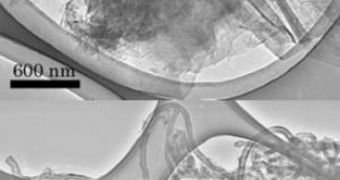Carbon nanotubes are, at this point, some of the most promising materials that science is developing. They are very tiny, and yet incredibly strong, and hold great promise for uses in medicine, biology and the electronics industry, among others. However, producing them is a very complex process, which relies on using metallic catalysts to boost the formation reaction. By accidents, experts looking for answer on how carbon gets recycled in outer space stumbles across a simple chemical reaction, which apparently produces the structures without the aid of metals. The finding could be used to promote advancements in nanotechnology, but also to clear out some mysteries related to supernovas.
The lab experiments that led to this conclusion were set up by researchers at the NASA Goddard Space Flight Center (GSFC), in Greenbelt, Maryland, under the supervision of expert Joseph Nuth. They were trying to figure out the recycling mechanisms which see to it that carbon gets circulated in regions of space that form new stars and planets. The experts found that a modest chemical reaction is capable of fulfilling this complex goal, without the aid of metal. Full details of their findings appear in the latest issue of the respected Astrophysical Journal Letters, ScienceDaily reports.
“[…] nanotubes were produced when graphite dust particles were exposed to a mixture of carbon monoxide and hydrogen gases,” Nuth says. “I am amazed at the implications of this paper, not only for astrophysics but also for materials science. Could Nature know a new chemistry for making carbon nanotubes that we have yet to discover?” says the chair of the Stanford University Chemistry Department, Dick Zare. Evidence collected in the field would seem to support this idea. In 2008, three meteorites were discovered to contain graphite whiskers, which are thin carbon structures that researchers consider to be the “older brother” of carbon nanotubes.
The discovery will most likely reshape the way in which nanotubes are produced in materials-science applications, if a production method based on the “cosmic approach” turns out to be effective. Experts say that the possibility to create tiny carbon tubes without metallic catalysts such as platinum would lower costs associated with CNT production considerably, potentially making them affordable for many people, and promoting their wide-scale acceptance by various industries.

 14 DAY TRIAL //
14 DAY TRIAL //